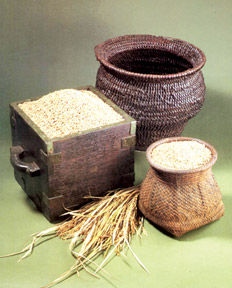Kem practices in paddy cultivation
Prof. W. I. Siriweera
The term Kem is derived from the Sanskrit kshema which means
protection. The earliest references to Kem are found in the thirteenth
century literary works Pujavaliya and Saddharmaratnavaliya but it is
possible that kem practices existed in society from earlier times.
The ancient Sri Lankan peasant like his modern counterpart considered
that plant diseases could be remedied, pests could be controlled and
harvest could be protected by resorting to certain Kem measures. For
instance, the smearing of paddy plants with ash in the morning was a
form of Kem practised from ancient times. The Tamil literary texts
Sekarasasekara Malai and Sarajothi Malai datable to the fourteenth and
fifteenth centuries state that ashes of the burnt wood of a ruined house
or hut were spread on the ridges of the paddy field with the belief that
it would protect the crop from birds, insects and wild animals.
|

Kem means protection for paddy fields |
Even at present smearing ash on paddy plants in the morning is
practised by many farmers all over the country. Before smearing ash,
water is drained from the field and after smearing, the field is kept
dry for four days. Due to the effect of ash, insects on paddy plants
move downwards from the plant and on to the soil. The eggs of the
insects are also wiped out by the farmer with a bundle of Keppetiya
(Croton lacciferous) leaves. After four days the field is inundated
again and the insects that moved down due to the effects of ash die in
water.
In remote areas of the Kurunegala district, insects that harm the
paddy plants were removed by burning dried leaves of Gandapana (Lantana
aculeate), Keppetiya, Dodampana (Glycosmis pentaphylla) and Sera (Cymbopogon
citrates). It was believed that fumigating would dispel the flies and
insects.
The Kem measures associated with smearing the crushed Madu (Cycas
circinalis), Valdel (Atrocarpus nobilis), Kokkana (Kokoona zeylanica),
Godapara (Dilleniaretusa), Demata (Gmelina asiatica) and Kukuruman (Randia
dumetorum) are observed in different regions of the country. Most of
these emanate a strong smell which is disliked by insects and so they
leave the paddy field.
Likewise, juice obtained by crushing roots or leaves of Katurumurunga
(Sebavia grandflora), Devata (Carallia brachiata), Kapparavalliya
(Coleus ambonicus), Daluk (Euphorbia antiquorum), Vara (Calatropis
giganta), Endaru (Ricinus communis), Niyangala (Gloriosa superbe),
Keppetiya and Karanda (Pongambia gabra) was mixed with water in the
paddy field by farmers to wade off the pests.
In Nuvarakalaviya and Tamankaduwa farmers prepare a concoction of
Magnesium sulphate (Sahinda lunu), Potash alum (Seenakkaran), Copper
sulphate (Palmanikkam) and allow it to mix in water of the paddyfield in
order to get rid of harmful pests.
A slightly different Kem measure was adopted by paddy farmers in
Siyane Korale, Hopitigam Korale, Alutkuru Korale, Hanguranketha and
Kotmale. They wetted a large piece of cloth by soaking it with a mixture
of resins (dummala) oil and fitted on to a rope. Before sunrise the rope
was dragged through the paddy field by two persons holding the ends and
insects got trapped in the sticky cloth.
The oil lamp or torch Kem (pahan kema) was another form of charm used
to dispel pests. For this purpose in most areas, tiny clay pots or
seedless raw papaya (Carica papaya) pieces were used as lamps. The oils
of either coconut (Cocos nucifera), Kohomba, Mi, Sesame or Kekuna (Scutinanthe
zeylanicum) was poured into these lamps and the wicks of the lamps were
burnt for three nights. In some areas torches made of rags of cloth
wetted with oil were used for this purpose.
The most elaborate protective rituals connected with paddy
cultivation were performed in the threshing floor. Before paddy was
brought for threshing, a pit of about three feet deep and half feet in
diameter was dug in the centre of the threshing floor. This is called
the Arakvala or the protection pit and it was meant to protect the
harvest from unseen forces or spirits. These spirits are called Bahirava
in Sinhala and Kuli in Tamil. Items such as betel, arecanut, coconut, a
bronze plate in which charms (Mantra) have been written, a piece of
turmeric, a piece of Kohomba wood, a piece of iron, bronze coins, sea
shells, leaves of trees such as Divikaduru (Rejona dichotama), Nika (Vitedx
negundo), Bo (Ficus religiosa) and Iluk (Imperata cylindrica), a small
round stone (arakgala) along with some ears of paddy were then placed in
the pit. The placing of these items in the pit were done at an
auspicious time.
Once the pit is closed, the trident (trisula), arrow, sword
symbolizing charms (Kamat Yatura) are drawn on the surface of the pit
with ash in three concentric circles. This stage of the ritual is called
'aluhan tabima' or ash placing ceremony.
Ash for the purpose was obtained either from the domestic hearth or
by burning dried kumbuk (Terminalia glabra), agil (Aquilaria agallocha),
citronella and cow dung in the paddy field itself.
In Northern Province, threshing rituals are slightly different and
the farmers there encircle the whole threshing floor with leaves or
pieces of bark of margosa and some creepers known as pirandai (Vitis
quadrangularis). An extempore image of Ganesha made of cow dung or soil
is also worshipped and rituals associated with splitting of coconut are
also conducted. Instead of making a cavity in the centre of the
threshing floor, a stake of a hard wood with a few ears of paddy and
margosa leaves is placed in the centre as an instrument of protection.
The ears of paddy are heaped round the stake for threshing.
Thus one can note that indigenous crop protection techniques were
environmentally friendly, harmless and some of them had a strong
scientific basis although peasants could not and did not explain them in
scientific terms. |



